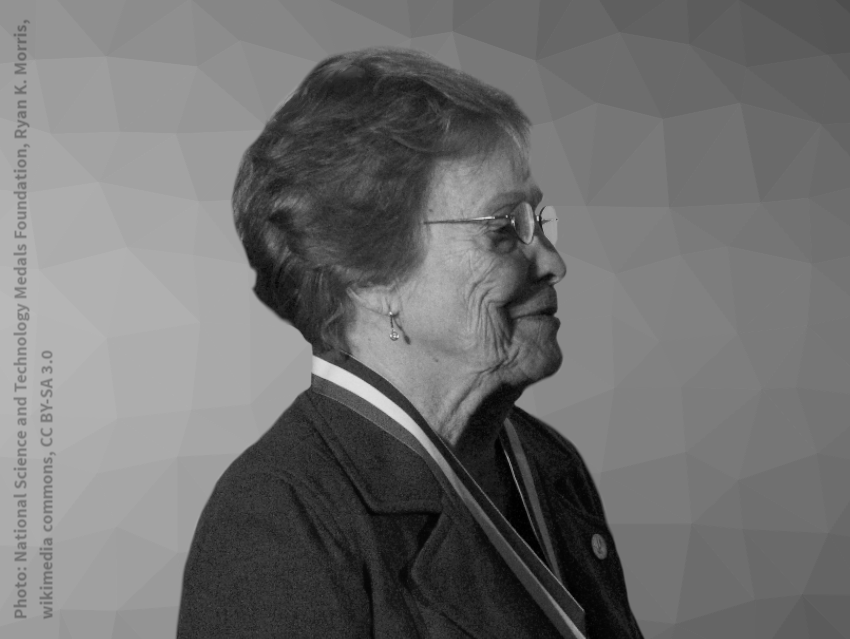Helen Murray Free (1923 – 2021) was an American chemist [1–6]. She is best known for revolutionizing at-home diagnostic testing for diabetes and other diseases by inventing dip-and-read test strips together with research partner and husband Alfred Free. The tests are still sold today.
“The Most Terrific Thing”
Helen Free, neé Murray, was born on February 20, 1923, in Pittsburgh, PA, USA. When she went to college at the College of Wooster, OH, USA, in 1941, she originally wanted to study Latin and English to become a teacher. However, after the attack on Pearl Harbor in December 1941, many of her male classmates went off to the army, and her housemother encouraged female students to switch majors because they were “going to need some scientists“ [1]. Free switched to chemistry, a decision she later commented on, “I think that was the most terrific thing that ever happened because I certainly wouldn’t have done the things I’ve done in my lifetime had I been a Latin and English teacher in some little high school somewhere.” [1].
Free completed a Bachelor of Science degree in 1944. She joined Miles Laboratories (later a part of Bayer Diagnostics) in Elkhart, IN, USA, in May 1944, first working in quality control for vitamin tablets. The company’s research facilities were expanded in 1946, and biochemist Alfred Free joined the laboratories. Free interviewed for a position in his research groups and was hired. Helen and Alfred were married in 1947, becoming both research and life partners.
Making Medical Tests Much More Convenient
Alfred Free had been involved in the development of Clinitest®, a tablet that could be used to test urine samples for glucose as an indicator of diabetes. The tablets contained cupric sulfate, sodium hydroxide, and citric acid mixed with a carbonate. After adding diluted urine to the tablet in a test tube, the resulting color change indicated the glucose levels in the sample. In the absence of glucose, which is a reducing agent, the solution remained blue, and with increasing levels of reduction, the color changed to green, brown, and finally orange. The test was much more convenient than previous methods and could be performed in, e.g., a doctor’s office or a hospital laboratory.
After joining Alfred’s research team, Helen Murray Free was involved in the development of a second test in tablet form that was useful for diabetes patients: Acetest®, which used nitroprusside to detect ketones. Acetest tablets were still sold until the 2010s. The team also developed Ictotest® (released in 1953), which is used to test urine samples for bilirubin, a sign of liver disease. The test, also in tablet form, is based on a diazotization reaction and shows a blue or purple color in the presence of bilirubin. It is still sold today.
As Helen Murray Free explains [1], Alfred Free had the idea to make the team’s tests even more convenient by moving from tablets to paper that is impregnated with the reagents. This would remove the need for test tubes, droppers, and the like, and allow even laypeople to perform the test. The team used filter paper strips, which were dipped into reagent solutions and then dried in an oven. This work resulted in the dip-and-read test Clinistix®, which was introduced in 1956 and is still available under the same name today. This invention was a breakthrough in urinalysis. It was specific for glucose, low-cost, and easy to use. Today, simple tests based on dip-and-read strips can be used for detecting a range of health conditions even under challenging conditions such as in developing countries.
Promoting Science Education
After her retirement in 1982, Helen Murray Free worked on promoting science education. For example, she was involved in the development of a “Kids & Chemistry” program, which offers hands-on science activities for elementary school students, and in the Association for Women in Science Mentoring Program. She was Chair of the ACS’s National Chemistry Week Task Force from 1987 to 1992, and served as ACS President in 1993, using the post to raise awareness of the contributions of chemistry to modern life. In addition to her outreach work, she also served as a consultant to Bayer AG, which had bought Miles Laboratories.
Among other honors, Helen Murray Free received the Garvan Medal of the American Chemical Society (ACS) in 1980, the U.S. National Medal of Technology in 2009, and the Chemical Pioneer Award in 2012. She was inducted to the U.S. National Inventors Hall of Fame in 2000 together with Alfred Free and was a Fellow of the American Association for the Advancement of Science. The ACS established the Helen M. Free Award for Public Outreach in 1995, which honors outstanding volunteer achievements that improve public recognition and appreciation for chemistry. Helen Murray Free was the first recipient of the award. She passed away on May 1, 2021, in Elkhart, IN, USA.
Helen Murray Free is the answer to Guess the Chemist (142).
References
[1] Bohning, James J., Science History Institute, Oral History Interview with Helen Murray Free, digital.sciencehistory.org. (accessed February 3, 2024)
[2] Science History Institute, Helen M. Free and Alfred Free, www.sciencehistory.org. (accessed February 3, 2024)
[3] American Chemical Society (ACS), Al and Helen Free and the Development of Diagnostic Test Strips: National Historic Chemical Landmark, www.acs.org. (accessed February 3, 2024)
[4] National Women’s Hall of Fame, Helen Murray Free, www.womenofthehall.org. (accessed February 3, 2024)
[5] American Chemical Society (ACS), Helen Free (1923–2021), www.acs.org. (accessed February 3, 2024)
[6] Massachusetts Institute of Technology (MIT), Helen Free: Dip-and-read Home Diabetes Test, lemelson.mit.edu. (accessed February 3, 2024)


